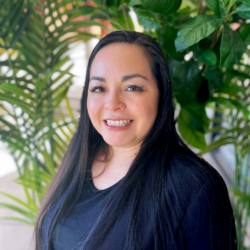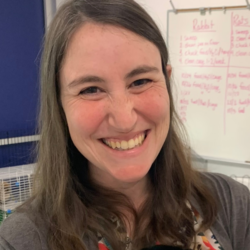In far too many schools across the country, teachers spend hours each week preparing lesson plans, activities, and materials for every class they teach. Despite teachers’ best efforts, this piecemeal approach to curriculum development means that the lessons and content students engage with vary widely, and may not be standards-aligned, culturally and linguistically responsive, or appropriately differentiated to reach all students. But if all schools provided high-quality curricula with built-in support and resources, teachers could instead focus their time, energy, and creativity on bringing lessons to life for students—not on searching for materials or preparing them from scratch.
Over the past several years, more and more states have mandated the use of high-quality instructional materials (HQIM) in all K-12 schools. But it’s critical that educators also receive professional learning and support to make a successful shift to new curricula, increasing their ability to deliver instruction that helps all students build a strong academic foundation. And while professional development can help seasoned educators adopt the new approach, there is great urgency for teacher preparation programs to incorporate high-quality instructional material training into their coursework, so that new teachers begin their careers equipped with the skills and knowledge to use the materials effectively from their first day in the classroom.
Dallas College: Transforming Teacher Preparation with High-Quality Instructional Materials & Research-Based Instructional Strategies
Dallas College, a Hispanic-Serving Institution (HSI) in North Texas, is one of the largest community college systems in the state. While enrollment in teacher preparation programs has declined nationally, the opposite is true for Dallas College. As the first community college in Texas to offer a bachelor’s degree in early childhood education and teaching, Dallas College has seen an increase in enrollment since it launched the bachelor’s degree in fall 2021. In addition to the bachelor’s degree program, its School of Education offers an alternative certification program called TEACH and an Associate of Arts in Teaching. More than 80% of students are aspiring educators of color, multilingual, and/or first-generation college students, helping to close the educator-to-student diversity gap. Dallas College is creating a pipeline of effective educators whose identities reflect the students and communities they will serve—and who will prepare all students to navigate the multicultural workforce of tomorrow.
The TEACH at Dallas College Educator Preparation Program was recently one of two educator prep programs to receive the commendation from the Texas Education Agency for “seeking innovative ways to prepare candidates for the classroom” in the 2022-23 school year. Emily Pierson, a Director of Academics with TNTP, spoke with Shannon Watson, Associate Dean at Dallas College, to discuss the key strategies driving the program’s success.
Key Strategy 1: Creating Pathways for Educators to Advance
Dr. Watson shared that when designing the educator preparation program, “our aim was removing barriers to give people already in education a pathway to earn a degree and teacher certification and thereby earn a higher wage.” Dallas College partnered with local education agencies (LEAs) to create a paid residency model. Teacher candidates spend a year working alongside a mentor teacher and gradually assuming more responsibilities in the classroom. Many of the people who enroll in the program already work in the education system. According to Watson, “offering this degree was a way to upskill people who are already working in [education] spaces and provide them a way to increase their earnings.”
Key Strategy 2: Engaging Faculty in the Greater Purpose
A first step toward embedding high-quality instructional materials and research-based instructional practices was for Dallas College to engage its faculty in a deeper understanding of why these shifts are critical for preparing effective teachers. TNTP’s 2018 report, The Opportunity Myth, helped faculty members connect to the urgency behind the shift, and demonstrated through data that HQIM, in combination with strong instruction, deep engagement, and high expectations among educators, not only helped improve students’ performance but also increased the likelihood that students who had fallen behind their peers could catch up.
“The faculty valued understanding The Opportunity Myth and the data around it,” explained Dr. Watson. “That training was a turning point for our faculty members. Until then, they didn’t seem to fully grasp why we were making this shift and why it was important to get on board with the initiative.”
Supporting faculty to make changes became an essential part of the process. “We had to think about how we could start small and build. As the last two years have progressed, I feel confident the faculty have embraced the direction we have gone and appreciate our hands-on approach,” explained Dr. Watson.
Key Strategy 3: Embedding High-Quality Instructional Materials into Coursework
With the faculty on board with the new direction, Dallas College began embedding Eureka Math and Amplify Reading in their coursework. Through strategic partnerships and faculty training facilitated by TNTP, teacher candidates gained valuable insights into maximizing the use of these specific curricula through research-based instructional strategies (RBIS).
Dallas College faculty learned how to help teacher candidates master relevant knowledge and skills, and then translate those into excellent classroom instruction. With the new coursework, faculty members challenged teacher candidates to explore examples of focus, coherence, and rigor in high-quality instructional materials. For example, by analyzing a Tier 1 lesson from Eureka Math for evidence of research-based instructional strategies and building on that deep analysis, teacher candidates would then prepare to implement that lesson with students, and receive constructive coaching based on faculty members’ observations of them in the field.
“Research-based instructional strategies and high-quality instructional materials position our teacher candidates to be ahead of the game when it comes to navigating the first-year teacher experience,” explained Dr. Joyce Price, a faculty member in the Dallas College School of Education. Rather than beginning their careers with the typical first-year teacher deficits, Price observed, “our teacher candidates, having had a year of paid, on-the-job training in real classrooms, will begin their careers with a deep understanding of how to build students’ conceptual understanding and the importance of equity in teaching and learning.”
Changing Teacher Preparation to Drive Student Success
Dallas College’s innovative approach to expanding the pipeline of local teacher candidates and infusing their preparation programs with high-quality instructional materials and practices is a powerful model for other programs to follow. Their program has the potential to impact the economic and social mobility of multiple generations of North Texans, from the teacher candidates in their programs to the K-12 students they will one day teach.
For educator preparation programs, state education agencies, and school systems ready to explore the potential of high-quality instructional materials to transform both student and educator experiences, TNTP can offer guidance and support contact us.








